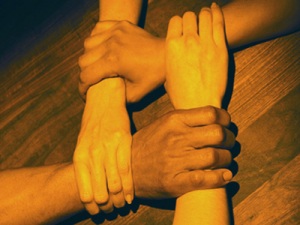
Here is a passage from my 2005 Bestseller, The Translucent Revolution.
Carolyn Anderson and John Zwerver, the founders of a UN-affiliated organization called Global Family, call this model of people working together "co-creation." Anderson is the co-author of The Co-Creators Handbook. She defines co-creation as "co-participating consciously with the laws or patterns of life itself, conscious alignment with the essence of others and with nature."
Anderson and Zwerver offer several other examples of co-creative businesses, where a CEO or president has embraced a position of stewardship, drawing out and giving voice to the innate wisdom of the collective.
For as long as we can remember, Iago-based business has used a dominator model. Decisions are made by the CEO and senior management, who are retained by investors to represent their interests: to make as much money as possible. The dominator model of doing business may make money, but the hidden cost is high.
First, everyone in the company, from middle management down to the shop floor, is placed in a position of subordination. Divorced from their own vision, their integrity and inspiration become entirely irrelevant in this ask-no-questions environment. If you want to keep your job, you don't question company policy. People feel used. Absenteeism and job turnover rise, since those doing the hands-on work feel little or no loyalty to the company, to its reputation, or to what it produces.
Second, with dominator models the source of innovation is restricted to senior management, which may be quite out of touch with the realities of what it really takes to care for patients in a hospital or to produce widgets on a factory floor. In a co-creative model, the source of new ideas can come from anywhere in the system. Rather than simply handing down orders, senior executives are responsible for creating an open listening environment, in which the voice of every participant can be heard. Anderson and Zwerver emphasize the necessity to create what they call a "resonant field," an invisible space that can resound, echo back, and affirm the highest good in one another. This frequency aligns individuals heart to heart, calling forth the gifts and creativity of each person. Hence the need for HeartMath tools, for Appreciative Inquiry, and for other companies to explore a whole host of spiritual practices. Co-creation happens when enough members of the organization are able to resonate at a translucent frequency together.
Co-creation doesn't mean that everyone performs the same function. There is still a place for some to lead, for some to keep track of accounts and statistics, for some to keep the environment clean and beautiful, and for some to serve the customers and their needs. Just like the organs and limbs of a body, every component of the system is recognized as equally valuable and necessary for its survival. Salary ratios reflect that recognition. The walls separating the different parts of the organism begin to come down. David Neenan literally brought down these walls of separation in his construction firm:
We were all in departments at the time. The department heads and I sat in the conference room and agreed on what we were going to do, then each department went its own way and everybody closed their door. This is the old way of doing business. It aggravated me so much that I got to thinking about it. I realized the reason we were not working together was that we could all close our doors, and that was really not okay. So I went to the janitor and asked him to take all the doors off over the weekend. By Monday morning there were no doors left, except on the bathrooms. Nobody said a word about it. A few days later, we were having a meeting in my doorless office. I had to pee. I had a little executive bathroom, and when I went in, I saw they had snuck in and taken the door off the bathroom, too. While I was peeing, my secretary came in the office and gasped. They had got me.
That's co-creation. Innovation can come from anywhere in the system.
To read more about a radically different way of looking at awakening, pick up your very own copy of Translucent Revolution today.
